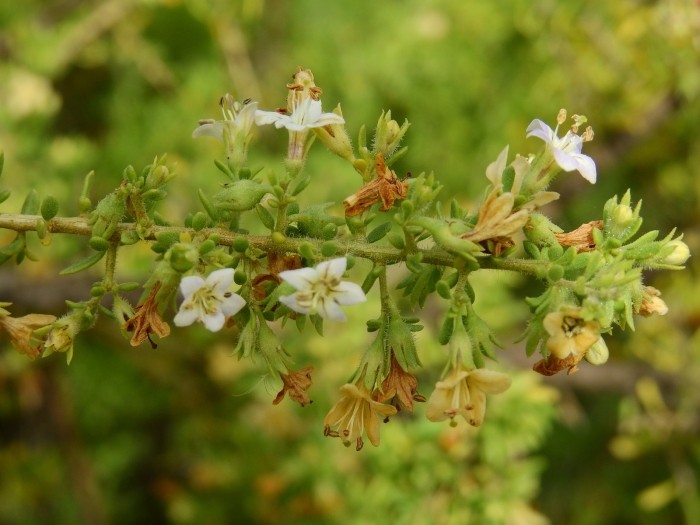Coralillo
(Lycium chilense)
Coralillo (Lycium chilense)
/
/

Guillermo Debandi
CC BY 4.0
Image By:
Guillermo Debandi
Recorded By:
Copyright:
CC BY 4.0
Copyright Notice:
Photo by: Guillermo Debandi | License Type: CC BY 4.0 | License URL: http://creativecommons.org/licenses/by/4.0/ | Rights Holder: Guillermo Debandi | Publisher: iNaturalist | Date Created: 2021-02-23T11:42:57-08:00 |

























Estimated Native Range
Summary
Lycium chilense, commonly known as Coralillo, Peruvian Wolfberry, Desert Thorn, or Chilean Boxthorn, is a deciduous shrub native to the arid and semi-arid regions of South America, particularly in Chile, Peru, and Argentina. It is typically found in desert mountains and on dry, rocky hillsides. This shrub exhibits a moderate growth rate and can reach a height and width of 3-8 feet (0.9-2.4 meters). Lycium chilense is characterized by its arching branches and small, lance-shaped leaves. It produces tubular, purple flowers that bloom in the spring and summer, which are followed by small, red berries that are attractive to birds and other wildlife.
The plant is valued for its drought tolerance and ability to thrive in challenging environments, making it suitable for xeriscaping and as an ornamental in arid gardens. It is also used for erosion control on slopes and banks. In cultivation, Lycium chilense requires full sun exposure and prefers medium or fast-draining soils such as clay, loam, or sandy types. It has low water needs once established, making it an excellent choice for water-wise gardening. While generally low-maintenance, it may require occasional pruning to maintain its shape and to remove any dead or damaged branches.CC BY-SA 4.0
The plant is valued for its drought tolerance and ability to thrive in challenging environments, making it suitable for xeriscaping and as an ornamental in arid gardens. It is also used for erosion control on slopes and banks. In cultivation, Lycium chilense requires full sun exposure and prefers medium or fast-draining soils such as clay, loam, or sandy types. It has low water needs once established, making it an excellent choice for water-wise gardening. While generally low-maintenance, it may require occasional pruning to maintain its shape and to remove any dead or damaged branches.CC BY-SA 4.0
Plant Description
- Plant Type: Shrub
- Height: 3-8 feet
- Width: 3-8 feet
- Growth Rate: Moderate
- Flower Color: Purple
- Flowering Season: Spring, Summer
- Leaf Retention: Deciduous
Growth Requirements
- Sun: Full Sun
- Water: Low
- Drainage: Medium, Fast
Common Uses
Deer Resistant, Drought Tolerant, Erosion Control, Low Maintenance
Natural Habitat
Native to arid and semi-arid regions of South America, particularly in desert mountains and on dry, rocky hillsides
Other Names
Common Names: Peruvian Wolfberry, Desert Thorn, Chilean Boxthorn
Scientific Names: , Lycium chilense, Lycium chilense var. gelidum, Lycium chilense var. odonellii, Lycium chilense var. ovatum, Lycium chilense var. petiolatum, Lycium chilense var. tomentosulum, Lycium fimbriatum, Lycium gelidum, Lycium grevilleanum
GBIF Accepted Name: